Contents
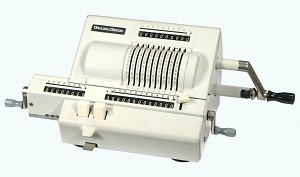
Contents |

|
| Original-Odhner Model 1049, c.1970 |

 W.T.Odhner's "Arithmometers" were built in St. Petersburg in Russia
from 1874, and under licence in Germany (as the Brunsviga) from 1892.
The name "Original-Odhner" was first used in about 1907. After the
Russian revolution in 1917 Original-Odhner was re-established in
Göteborg (Gothenburg) in Sweden. The new firm built a very
successful range of pinwheel calculators which adhered closely to the
traditional design. Production of Odhner-style machines also continued
in Soviet Russia under various state-run enterprises.
W.T.Odhner's "Arithmometers" were built in St. Petersburg in Russia
from 1874, and under licence in Germany (as the Brunsviga) from 1892.
The name "Original-Odhner" was first used in about 1907. After the
Russian revolution in 1917 Original-Odhner was re-established in
Göteborg (Gothenburg) in Sweden. The new firm built a very
successful range of pinwheel calculators which adhered closely to the
traditional design. Production of Odhner-style machines also continued
in Soviet Russia under various state-run enterprises.
In 1942 Original-Odhner became part of Atvidaberg Industries, a Swedish office equipment company which also produced the Facit calculator range. It seems probable that there was an earlier connection between the two firms, as the Odhner Model 7 machine was also sold as a Facit Model S from 1935.
In 1932 Odhner introduced a ten-key adding and listing machine, initially with a two-row keyboard and later with the now-familiar numeric keypad. During the 1950s and 60s some versions of the printing calculators were sold under both Odhner and Facit brands.
In 1966 Atvidaberg absorbed the Swedish Addo company and its range of printing and pinwheel calculators. Late-model Odhner machines were also sold under the Addo brand, until production ended in the early 1970s.
The photo opposite shows a consignment of Odhner machines for Buenos Aires being loaded in the harbour at Gothenburg, c.1950.
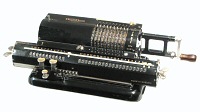 Original-Odhner Model 11, S/N 63128
Original-Odhner Model 11, S/N 63128
Digits: 10 rotor, 11 counter, 20 accumulator
Dimensions: Body 240W x 150D x 120H, overall width 440mm
Weight: 6.9 kg
Manufactured: Göteborg, Sweden, around 1924
This early Original-Odhner does not show a model number, but it appears to be a Model 11. The serial number 63128 suggests that it was made in about 1924. The machine is solidly built of cast iron and brass, and finished in glossy black lacquer. The mechanism is based on W.T.Odhner's design from 1890, and is typical of the entire Odhner production. Subsequent models added only minor variations in features and styling, and gradual simplification of the internal construction.
The rotor pinwheels are 54mm in diameter, with the setting levers spaced 7mm apart. There is a two-stage rotor clearing mechanism operated by the button at the lower left of the setting levers. As the button is pushed to the left it brings a shutter into the path of the levers, releases the setting lock on the rotor, and releases the rotor non-return pawl. As the winding handle is turned forward, the setting rings stop against the shutter and the rotor continues to turn under them, until they are all back at zero. The handle is then returned to the home position and the button released.
The carriage contains the counter and accumulator registers, which are cleared by a full turn of the wing nuts on either end. The accumulator carry mechanism extends only to 13 places. The counter register has a full tens-carry mechanism, with a manual reversing mechanism operated by the small +/- lever at the top left corner of the machine. The carriage can be moved one step in either direction by the two buttons at the front left of the machine, or continuously by pressing the small lever between the buttons. The buttons are attached to the base rather than the carriage, and operate vertically rather than horizontally, thus avoiding any tendency to move the whole machine.
 Original-Odhner "LUSID", S/N 124446
Original-Odhner "LUSID", S/N 124446
Digits: 10 rotor, 15 counter, 10 accumulator
Dimensions: Body 240W x 150D x 120H, overall width 440mm
Weight: 6.9 kg
Manufactured: Göteborg, Sweden, 1920s
In the early 1920s Odhner developed a range of pinwheel machines for calculations in Sterling currency. The machines were sold under the name "LUSID", from the usual notation "L.s.d" for pounds, shillings, and pence. Martin describes six LUSID models (A to H), each adapted to a specific type of Sterling-currency calculation.
The machine illustrated is generally similar to the Model 11 above, but has very different arrangements in the carriage registers. The accumulator has only ten places, the first three of which are replicated in reverse order towards the far right-hand end of the carriage. A sliding lever operates a pair of shutters to display different groups of digits. The counter register has two sets of six white dials, with three red dials between them. There are two counter drive pawls located three places apart, and interconnected with the carriage position by sliding cams.
The functions of this machine are not at all obvious. It appears to have been "investigated" many times in its 80-year history, and may not be in its original configuration.
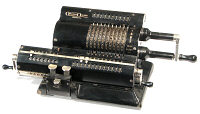 Original-Odhner Model 22, S/N 156674
Original-Odhner Model 22, S/N 156674
Digits: 10 rotor, 8 counter, 13 accumulator
Dimensions: Body 195W x 140D x 130H, overall width 350mm
Weight: 5.3 kg
Manufactured: Göteborg, Sweden, 1936-
The "20" models fron the mid-1930s have a more angular base-plate, with handles instead of wing nuts for clearing the carriage registers. The carriage frame is a one-piece alloy die-casting with a greatly simplified construction. The rotor pinwheels have changed from machined brass to a die-cast alloy, but the base and end plates are still of cast iron.
This Model 22 has a check dial mounted above the setting levers, with a rear panel that slopes backwards to accommodate the dial mechanism. There is a rotor quick-clearing button on the right-hand side, where it can be operated with the thumb as the handle is turned. There is no back-transfer mechanism, and no tens-carry on the counter register.
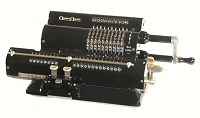 Original-Odhner Model 23, S/N 149877
Original-Odhner Model 23, S/N 149877
Digits: 10 rotor, 8 counter, 13 accumulator
Dimensions: Body 220W x 140D x 130H, overall width 340mm
Weight: 7.0 kg
Manufactured: Göteborg, Sweden, 1936-
Model 23 is similar to the Model 22 above, but with the addition of tens-carry and automatic reversing mechanisms on the counter. If the first turn of the winding handle is negative (as in division), the mechanism will reverse the counter so that it shows positive values rather than complements. The mechanism is reset when the counter is cleared. The body of the machine is extended by 25mm on the left-hand side to accommodate the reversing mechanism.
The machine illustrated is fitted with an unusual extended carriage with both clearing controls on the right-hand side. Either or both of the vertical levers can be pressed rearwards through 90° to clear the corresponding register. The register detents are released during clearing to provide a very quick and light action. The carriage is extended by 25mm at each end to accommodate the ratchet drive and 1:4 step-up gearing for the clearing mechanisms. The carriage is heavily built from cast iron and brass, in a similar manner to the early Odhner machines.
Counter reversing mechanism (37kb)
Accumulator clearing mechanism (29kb)
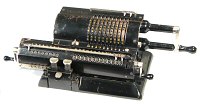 Original-Odhner Model 27, S/N 246605
Original-Odhner Model 27, S/N 246605
Digits: 10 rotor, 8 counter, 13 accumulator
Dimensions: Body 195W x 140D x 125H, overall width 350mm
Weight: 5.2 kg
Manufactured: Göteborg, Sweden, 1938-
Model 27 has no check dial or counter carry mechanism, but is fitted with a back-transfer mechanism to allow a sum or product to be re-used in a subsequent calculation. On completion of the first calculation the operator clears the rotor and presses the back-transfer lever (at the right of the carriage). As the accumulator is then cleared, the mechanism transfers its contents back to the rotor. A small release lever is provided below the back-transfer button, in case it was pressed accidentally. The back-transfer mechanism became standard equipment on most subsequent models.
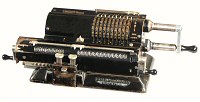 Original-Odhner Model 29, S/N 280948
Original-Odhner Model 29, S/N 280948
Digits: 10 rotor, 8 counter, 13 accumulator
Dimensions: Body 220W x 140D x 125H, overall width 370mm
Weight: 5.6 kg
Manufactured: Göteborg, Sweden, 1938-
Model 29 includes the back-transfer mechanism, and the tens-transfer and automatic reversing on the counter register, but it does not have the setting check dial.
 Original-Odhner Model 127, S/N 660706
Original-Odhner Model 127, S/N 660706
Digits: 10 rotor, 8 counter, 13 accumulator
Dimensions: Body 195W x 140D x 125H, overall width 350mm
Weight: 5.1 kg
Manufactured: Göteborg, Sweden, 1950-51
The construction of the Odhner machines was further simplified with the introduction of the 100 series in 1950, although there was little change to the external appearance. The base and frame were changed from cast iron to die-cast alloy, and the internal mechanisms were re-designed on a much more modular basis.
This Model 127 has the same features as the earlier Model 27 (above). The colour scheme has changed from black to blue, and the carriage shift controls have been replaced with rectangular plastic buttons. The rotor clearing button has been removed from the right-hand side of the machine and replaced with another small tab between the carriage shift buttons. This was not an improvement, as it made clearing the rotor into a two-handed operation. It was corrected in the 200 series from 1955.
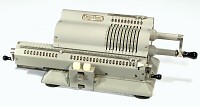 Original-Odhner Model 125, S/N 784285
Original-Odhner Model 125, S/N 784285
Digits: 10 rotor, 11 counter, 20 accumulator
Dimensions: Body 240W x 150D x 140H, overall width 420mm
Weight: 6.7 kg
Manufactured: Göteborg, Sweden, 1952-55
Model 125 is a full-featured wide-carriage machine with a 20-digit accumulator, a setting check dial, a back transfer mechanism, and a tens-carry mechanism with automatic reversing on the counter register. The machine is finished in the new grey colour scheme from 1952.
The check dial, tens carry, and reversing mechanisms are each designed as separate modules or sub-assemblies, rather than the built-in-place mechanisms of the earlier 20-series machines.
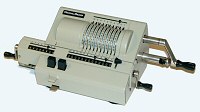 Original-Odhner Model 227, S/N 903334
Original-Odhner Model 227, S/N 903334
Digits: 10 rotor, 8 counter, 13 accumulator
Dimensions: Body 185W x 160D x 125H, overall width 380mm
Weight: 5.5 kg
Manufactured: Sweden, 1955-
The Original-Odhner machines were re-styled in 1955, with a new all-alloy casing in various shades of grey. The 200 series was built from 1955 until the end of production in the early 1970s.
The attractive and functional styling of these machines is the work of Sigvard Bernadotte, a distinguished silversmith and industrial designer and a member of the Swedish royal family. The mechanism is basically identical to that of the Model 127 above.
A machine similar to this was the first and only mechanical calculator that I have ever used in earnest. I took Mathematical Methods at university in 1965, and spent many hours computing difference tables on a brand-new pin-wheel calculator.
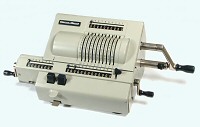 Original-Odhner Model 239, S/N 892255
Original-Odhner Model 239, S/N 892255
Digits: 10 rotor, 8 counter, 13 accumulator
Dimensions: Body 185W x 170D x 135H, overall width 380mm
Weight: 6.2 kg
Manufactured: Sweden, 1955-1967
Model 239 has a check dial above the setting rings, and a tens-carry mechanism with automatic reversing on the counter register. The case is slightly deeper and higher than the Model 227 in order to accommodate the check dial.
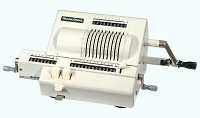 Original-Odhner Model 1049, S/N 55324
Original-Odhner Model 1049, S/N 55324
Digits: 10 rotor, 8 counter, 13 accumulator
Dimensions: Body 185W x 170D x 135H, overall width 380mm
Weight: 6.2 kg
Manufactured: Sweden, 1967-
The Odhner model numbering was changed to a 1000-series in 1967, with the colour scheme changing to a very light grey and white. The mechanism of this Model 1049 is identical to Model 239.
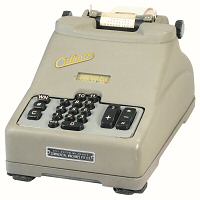 Original-Odhner Model LX11C-5, S/N 190248
Original-Odhner Model LX11C-5, S/N 190248
10/11 columns, Sterling currency, electric
Dimensions: 210W x 385D x 200H
Weight: 11.3 kg
Manufactured: Sweden, 1950s
The Odhner LX11C-5 is a motor-driven adding and listing machine for Sterling currency. The keypad has two additional keys for 10 and 11 pence, but there are no Farthings.
The two function keys on the right-hand side serve dual purposes. The Add key will add if there is an entry in the keyboard, or take a sub-total if nothing has been entered since the last operation. Subtract and Total are combined on the other key in a similar manner. There is a Repeat key next to the two function keys, with Non-add and Clear keys at the left-hand side. A key marked WN (for Whole Numbers) switches the machine from 10-column Sterling into 7-column decimal mode.
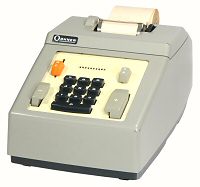 Original-Odhner Model E11C-2, S/N 121850
Original-Odhner Model E11C-2, S/N 121850
10/11 columns, electric
Dimensions: 185W x 340D x 150H
Weight: 6.2 kg
Manufactured: Sweden, around 1965
The Odhner E11C-2 is a basic motor-driven add-list machine for decimal currency. The machine has the Add and Subtract keys on opposite sides of the keypad. Two sliding buttons control the Repeat/Clear and Total/Subtotal functions.
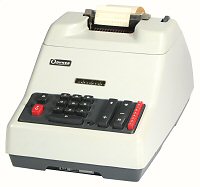 Original-Odhner Model XX11C-9, S/N 979013
Original-Odhner Model XX11C-9, S/N 979013
10/11 columns, electric
Dimensions: 230W x 380D x 200H
Weight: 10.5 kg
Manufactured: Sweden, late 1960s
The Odhner XX11C-9 is a large electrically-driven machine which includes a mechanism for semi-automatic multiplication.
The first factor is set on the keyboard in the normal manner. The multiplier is entered one digit at a time (starting with the least significant) on the red auxilliary keyboard at the far right-hand side. The multiplier keys are so small that a normal finger will press about three at a time, but the mechanism is designed so that only the highest key will take effect.
This machine performs "short-cut" multiplication for digits 6 to 9. For example, to multiply by 8 the machine subtracts twice then adds once in the next column, so that the operation is completed in three machine cycles instead of eight. When all digits have been processed the operator clears the keyboard and takes a total to print the result. The clearing function has been designed so that if the key is held down, the machine will make another cycle and take the total automatically.
The instruction booklet for this machine is dated 1965. It includes an illustration of a similar machine with a wide paper carriage, captioned as a "fully automatic bookkeeping machine with electronic line-finder".
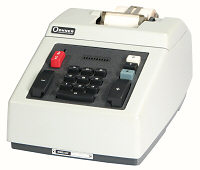 Original-Odhner Model 1207, S/N 382604
Original-Odhner Model 1207, S/N 382604
10 columns, electric
Dimensions: 195W x 340D x 150H
Weight: 6.3 kg
Manufactured: Sweden, around 1970
The Odhner 1207 is a motor-driven machine for decimal currency, from around 1970. It is generally similar to the E11C-2 above, but has separate keys for Total, Sub-total, and Non-add on the right-hand side.